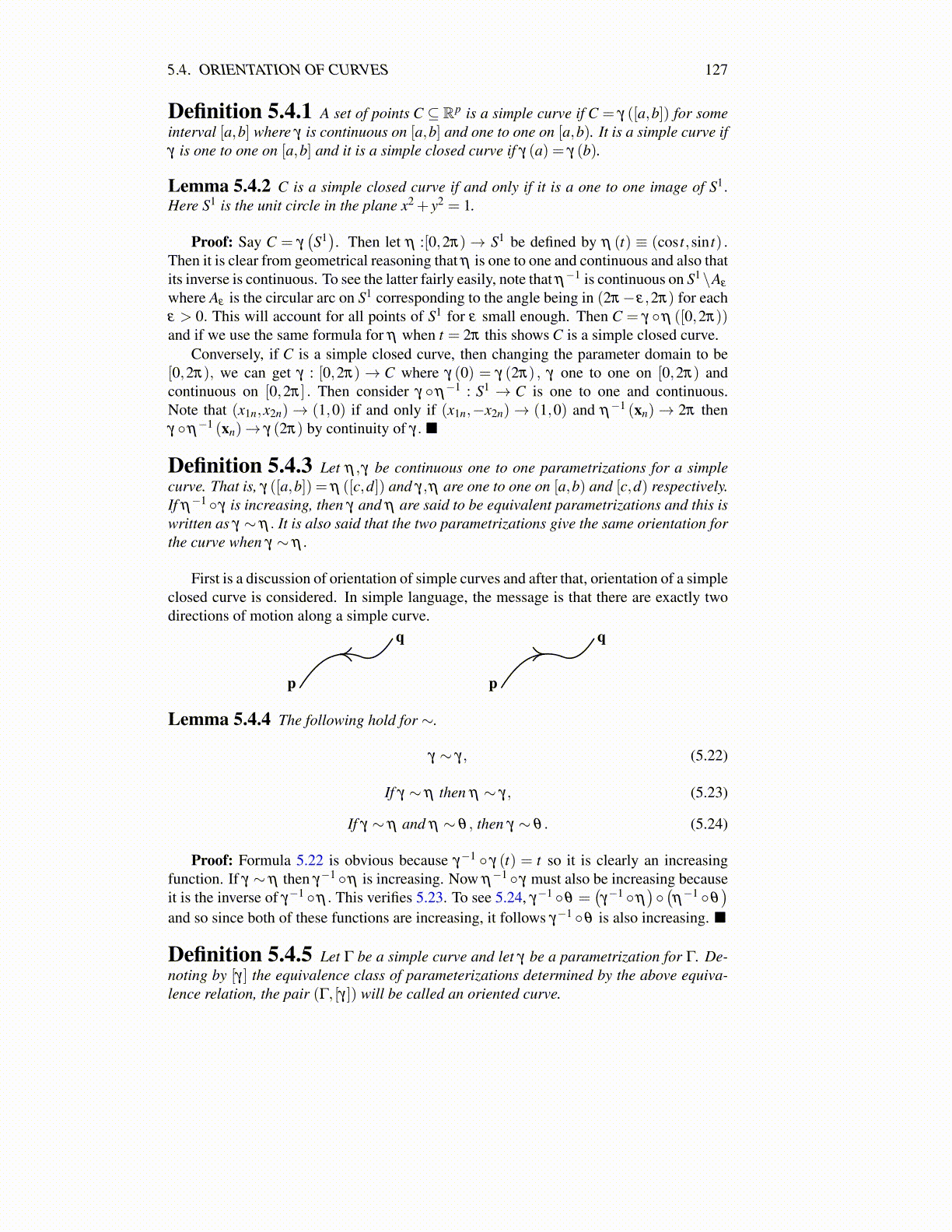
5.4. ORIENTATION OF CURVES 127
Definition 5.4.1 A set of points C ⊆ Rp is a simple curve if C = γ ([a,b]) for someinterval [a,b] where γ is continuous on [a,b] and one to one on [a,b). It is a simple curve ifγ is one to one on [a,b] and it is a simple closed curve if γ (a) = γ (b).
Lemma 5.4.2 C is a simple closed curve if and only if it is a one to one image of S1.Here S1 is the unit circle in the plane x2 + y2 = 1.
Proof: Say C = γ(S1). Then let η :[0,2π)→ S1 be defined by η (t) ≡ (cos t,sin t) .
Then it is clear from geometrical reasoning that η is one to one and continuous and also thatits inverse is continuous. To see the latter fairly easily, note that η−1 is continuous on S1\Aε
where Aε is the circular arc on S1 corresponding to the angle being in (2π−ε,2π) for eachε > 0. This will account for all points of S1 for ε small enough. Then C = γ ◦η ([0,2π))and if we use the same formula for η when t = 2π this shows C is a simple closed curve.
Conversely, if C is a simple closed curve, then changing the parameter domain to be[0,2π), we can get γ : [0,2π) → C where γ (0) = γ (2π) , γ one to one on [0,2π) andcontinuous on [0,2π] . Then consider γ ◦η−1 : S1 → C is one to one and continuous.Note that (x1n,x2n)→ (1,0) if and only if (x1n,−x2n)→ (1,0) and η−1 (xn)→ 2π thenγ ◦η−1 (xn)→ γ (2π) by continuity of γ. ■
Definition 5.4.3 Let η ,γ be continuous one to one parametrizations for a simplecurve. That is, γ ([a,b]) = η ([c,d]) and γ,η are one to one on [a,b) and [c,d) respectively.If η−1 ◦ γ is increasing, then γ and η are said to be equivalent parametrizations and this iswritten as γ ∼ η . It is also said that the two parametrizations give the same orientation forthe curve when γ ∼ η .
First is a discussion of orientation of simple curves and after that, orientation of a simpleclosed curve is considered. In simple language, the message is that there are exactly twodirections of motion along a simple curve.
p
q
p
q
Lemma 5.4.4 The following hold for ∼.
γ ∼ γ, (5.22)
If γ ∼ η then η ∼ γ, (5.23)
If γ ∼ η and η ∼ θ , then γ ∼ θ . (5.24)
Proof: Formula 5.22 is obvious because γ−1 ◦ γ (t) = t so it is clearly an increasingfunction. If γ ∼ η then γ−1 ◦η is increasing. Now η−1 ◦ γ must also be increasing becauseit is the inverse of γ−1 ◦η . This verifies 5.23. To see 5.24, γ−1 ◦θ =
(γ−1 ◦η
)◦(η−1 ◦θ
)and so since both of these functions are increasing, it follows γ−1 ◦θ is also increasing. ■
Definition 5.4.5 Let Γ be a simple curve and let γ be a parametrization for Γ. De-noting by [γ] the equivalence class of parameterizations determined by the above equiva-lence relation, the pair (Γ, [γ]) will be called an oriented curve.